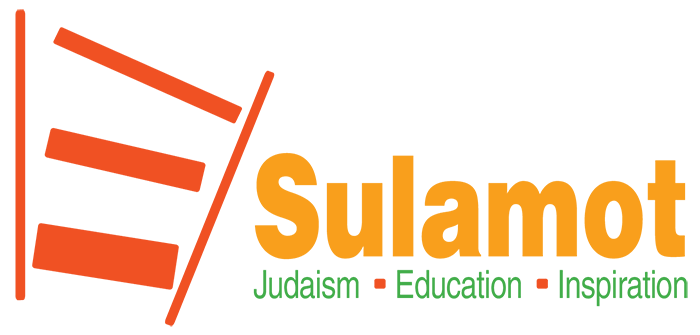Sulamot Mishna Series
The Sulamot LaMishna project engages students in a relevant and meaningful way. We teach students the skills they need to learn Mishna guided by the philosophy that when students know how to learn, they love to learn.
We offer a customizable and flexible system for Mishna study that covers approximately twenty mishnayot per semester. Two books (Shas 1 and Shas 2) include an assortment of mishnayot (4-5 mishnayot from 4 different masechetot), while the other three books focus on specific masechtot (Brachot, Rosh Hashana, and Sukka). Every book has an introduction to Mishna study, to our unique methodology, and to COMDaT. The Sulamot LaMishna Series is geared towards grades 4 through 7.
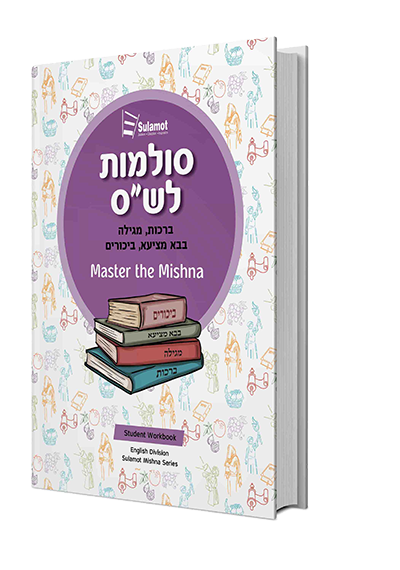
Sulamot LaShas 1
This workbook includes an iyun component taken from four mishnayot for a total of 17 mishnayot:
- Brachot (Chapter 1)
- Megillah (2:1, 2:2, 3:1, 4:1)
- Bava Metzia (2:1, 2:2, 2:3, 2:4)
- Bikkurim (3:1, 3:2, 3:6, 3:9)
The workbook starts with an introduction to learning mishna and the COMDaT methodology. Each masechet has its introduction that details an overview of the masechet’s topics.
Sulamot’s unique methodology allows students to build and develop independent study skills, understand the structure of a Mishna utilizing COMDaT, learn new concepts, and apply them to Jewish studies and Jewish living. All materials can also be accessed on our digital platform Class-E which creates a broad range of exciting pedagogical possibilities.
Sulamot LeShas 2
This workbook includes an iyun component taken from four mishnayot for a total of 17 mishnayot:
- Brachot (Chapter 9)
- Taanit (1:1, 1:2, 1:3,1:4)
- Bava Kamma (1:1, 3:1, 3:4, 8:1)
- Rosh HaShana (1:1, 1:2, 1:3, 3:7)
The workbook starts with an introduction to learning mishna and the COMDaT methodology. Each masechet has its introduction that details an overview of the masechet’s topics.
Sulamot’s unique methodology allows students to build and develop independent study skills, understand the structure of a Mishna utilizing COMDaT, learn new concepts, and apply them to Jewish studies and Jewish living. All materials can also be accessed on our digital platform Class-E which creates a broad range of exciting pedagogical possibilities.
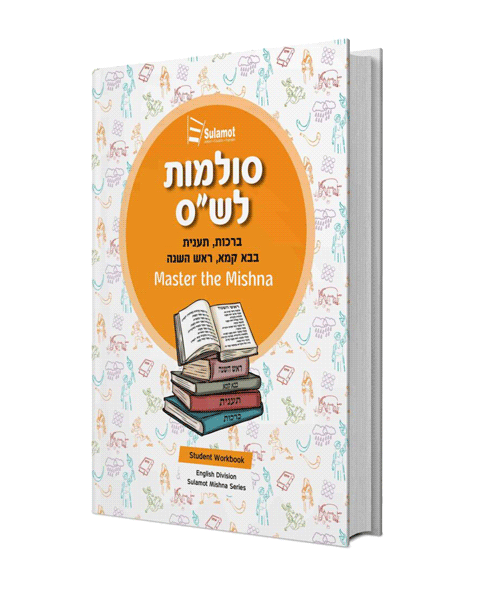

Sulamot LeBrachot
This workbook includes iyun and bekiut components to master knowledge and skills while also completing the masechet.
The iyun section has 27 mishnayot and it covers the topics of דיני תפילות and .ברכות הנהנין
Chapter 1 – all mishnayot
Chapter 4 – all mishnayot
Chapter 5: Mishna 1 and 2
Chapter 6 – all mishnayot
Chapter 9 – all mishnayot
The beqiut section covers all the mishnayot of the masechet.
The workbook starts with introductions to learning Mishna, the COMDaT methodology, as well as an introduction that details an overview of the masechet’s topics.
Sulamot’s unique methodology allows students to build and develop independent study skills, understand the structure of a Mishna utilizing COMDaT, learn new concepts, and apply them to Jewish studies and Jewish living. All materials can also be accessed on our digital platform Class-E which creates a broad range of exciting pedagogical possibilities.
Sulamot LeRosh HaShana
This workbook includes iyun and bekiut components to master knowledge and skills while also completing the masechet.
The iyun section covers 20 mishnayot on the topic of קידוש החודש:
Chapter 1 – all mishnayot
Chapter 2 – all mishnayot
Chapter 3: Mishna 1 and 7
The beqiut section covers all the mishnayot of the masechet.
The workbook starts with introductions to learning Mishna, the COMDaT methodology, as well as an introduction that details an overview of the masechet’s topics.
Sulamot’s unique methodology allows students to build and develop independent study skills, understand the structure of a Mishna utilizing COMDaT, learn new concepts, and apply them to Jewish studies and Jewish living. All materials can also be accessed on our digital platform Class-E which creates a broad range of exciting pedagogical possibilities.
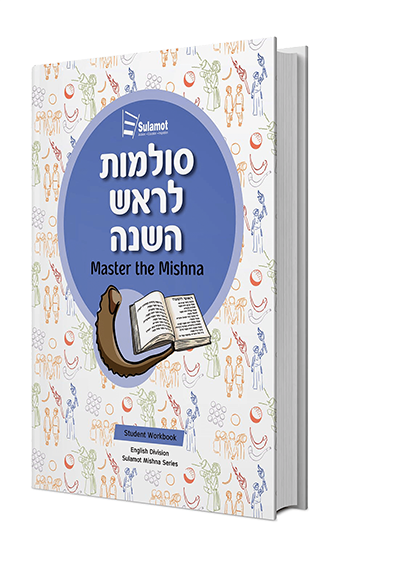
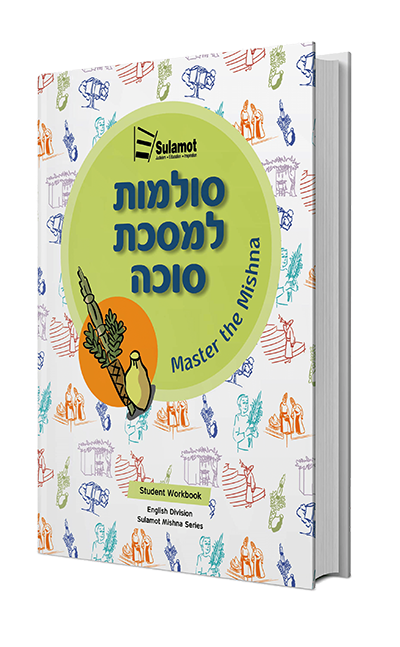
Sulamot LeSukka
This workbook includes iyun and bekiut components to master knowledge and skills while also completing the masechet.
The iyun section covers 28 mishnayot in-depth:
Chapter 2: mishnayot 1-9
סוכה
Chapter 3: mishnayot 1-15
ארבעת המינים
Chapter 5: Mishnayot 1-4
שמחת בית השואבה
The bekiut section covers all the mishnayot of the masechet.
The workbook starts with introductions to learning Mishna, the COMDaT methodology, as well as an introduction that details an overview of the masechet’s topics.
Sulamot’s unique methodology allows students to build and develop independent study skills, understand the structure of a Mishna utilizing COMDaT, learn new concepts, and apply them to Jewish studies and Jewish living. All materials can also be accessed on our digital platform Class-E which creates a broad range of exciting pedagogical possibilities.
Mesora - A guide to Torah Sheb’al Peh (Oral Law)
This curriculum is meant to prepare students to enter the world of Torah Sheb’al Peh (Oral Law). By understanding the historical and philosophical underpinnings of the Torah Sheb’al Peh, students will learn how Judaism as we know it developed from Moshe to the Mishna, to the Gemara, and into the modern period.
Students will develop an understanding and appreciation of the mesora so that they will have confidence in the authenticity of Torah Sheb’al Peh. The curriculum traces the development of Torah throughout the eras, meeting the personalities who animated that process. The sources, guided questions, and activities, encourage students to engage these critical issues in a substantive, interactive, and fun way. This curriculum is appropriate for grades 7 through 10.
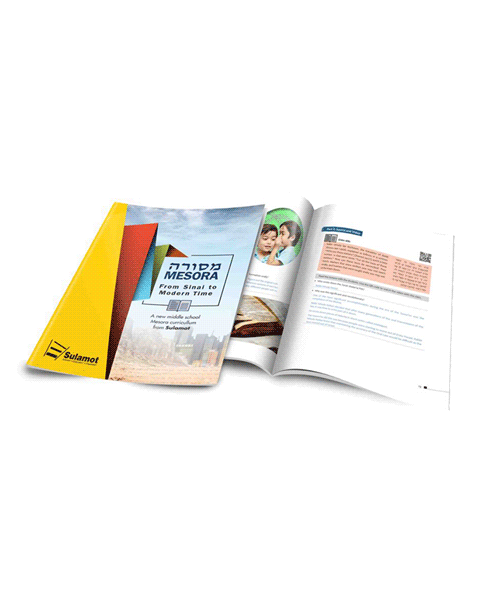
Sulamot Tefilla Series
In the spirit of Rav Yosef Zvi Rimon’s Halacha Mimkora book series, Sulamot LaHalacha unpacks the halachic process for students – from the Torah through poskei zemaneinu. Students learn technical aspects of the halacha as well as exploring the meaning behind the halachot. Sulamot connects halacha to the students’ lives making it relevant and exciting. Students can discuss halacha intelligently with the tools they gain and formulate their own judgments, and most importantly, appreciate the complexity and beauty of the halachic system.
The Ethics & Values and Tefillah curricula were developed through a partnership between Yeshivah of Flatbush and Sulamot. The Sulamot staff was tasked with designing and creating the curricular units and the Yeshivah of Flatbush educational staff implemented it in the classroom. The synergy between the Yeshivah of Flatbush and Sulamot staff serves as a model for future creators of Torah curricular materials. Sulamot’s expertise in writing and developing curriculum coupled with Yeshivah of Flatbush’s proficiency in pedagogy and classroom implementation produced an inspiring, rigorous, and relevant curriculum.
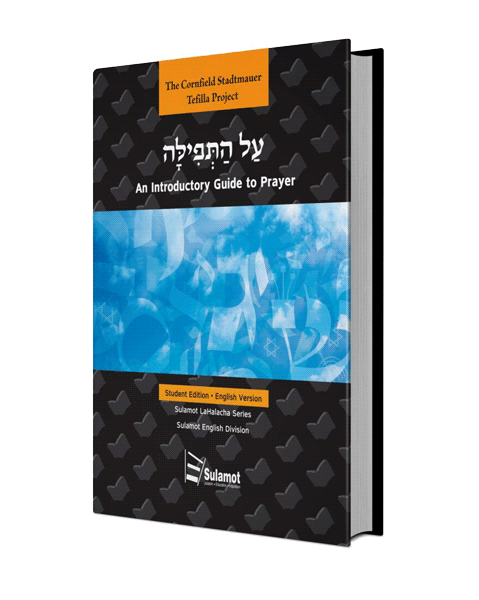
An Introductory Guide to Prayer
This curriculum addresses three areas pertaining to prayer:
- Understanding the structure and content of the prayer
- The laws of prayer
- Developing a meaningful prayer
Throughout the discussion of these topics, students are presented with questions and issues relevant to the day-to-day life of a student. Videos are incorporated to engage students in varied ways. Students are asked to apply the sources that they read to acquire a better understanding of all aspects of prayer. This approach will inspire students to understand, appreciate, and love prayer. This book is written in easy Hebrew or English, organized by topic, and utilizes clear charts to summarize the content of each unit. It is packed with inspirational stories, points to ponder, parent/child learning, and practical suggestions on making prayer more meaningful. Prayer will come alive with the help of relevant examples from everyday life. Studying with Sulamot will transform student prayer into a profound and fulfilling endeavor. The curriculum is appropriate for grades 6 through 9.
Sulamot Halacha Series
In the spirit of Rav Yosef Zvi Rimon’s Halacha Mimkora book series, Sulamot LaHalacha unpacks the halachic process for students – from the Torah through poskei zemaneinu. Students learn technical aspects of the halacha as well as exploring the meaning behind the halachot. Sulamot connects halacha to the students’ lives making it relevant and exciting. Students can discuss halacha intelligently with the tools they gain and formulate their own judgments, and most importantly, appreciate the complexity and beauty of the halachic system.
The Ethics & Values and Tefillah curricula were developed through a partnership between Yeshivah of Flatbush and Sulamot. The Sulamot staff was tasked with designing and creating the curricular units and the Yeshivah of Flatbush educational staff implemented it in the classroom. The synergy between the Yeshivah of Flatbush and Sulamot staff serves as a model for future creators of Torah curricular materials. Sulamot’s expertise in writing and developing curriculum coupled with Yeshivah of Flatbush’s proficiency in pedagogy and classroom implementation produced an inspiring, rigorous, and relevant curriculum.
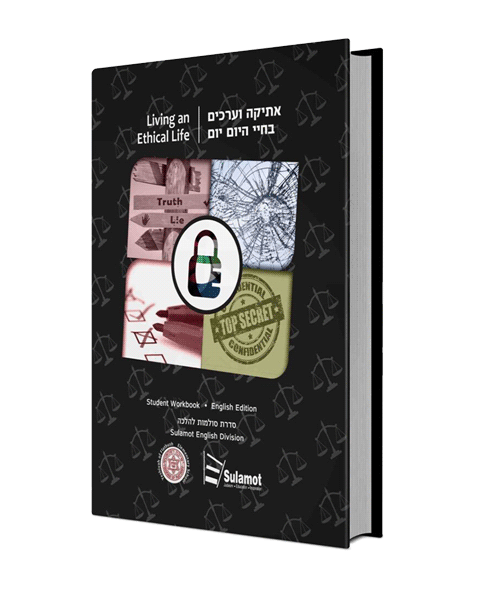
Ethics and Values in Everyday Life
The Ethics and Values in Everyday Life curriculum includes a rigorous text-based approach providing students an understanding of the halachic process of psak through applying the sources to everyday scenarios. This workbook is ideal for Halacha or Toshba classes.
Each unit includes an engaging, topical video that demonstrates the issues in the unit. This project addresses topics relating to the day-to-day life of an adolescent including Damaging a Person or his Property, Guarding a Person or his Property, Speaking Truth and Avoiding Falsehood, Misleading and Deceiving, and Revealing Secrets and Spreading Information. The real-life scenarios drive the content and motivate the students to delve into the sources, studying and analyzing them. The sources are color-coded by time period, helping the students trace the halachic process from the psukim to contemporary poskim. Engaging videos accompany the written material as well. As students apply the sources to the specific cases, they can understand the work of a posek (decisor of Jewish law) and appreciate the important role that our Rabbis play in Halacha. This curriculum is appropriate for grades 8 through 10.
VeHalachta BeDrachav
In this character-building curriculum, designed for a broader audience, students learn what it means to live a values-based life. Topics studied include The Art of Deception, Lashon Hara, Beyond the Letter of the Law, Human Dignity, and Loving your Fellow. Through entertaining trigger clips, engaging discussion questions, stories, and a range of Torah sources, students acquire an understanding of following in God’s footsteps. The sources are color-coded by time period, helping the students trace the halachic process from the psukim to contemporary poskim.
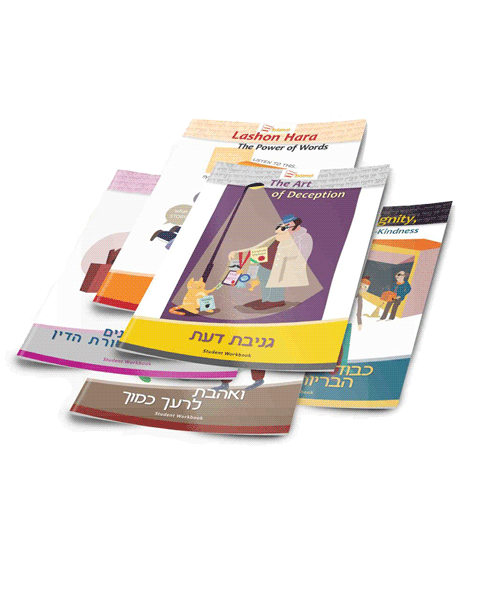

Hilchot Shabbat שמור וזכור
Hilchot shabbat שמור וזכור includes both the זכור (קידוש and other positive mitzvot) and שמור (מלאכה and other prohibitions) aspects of שבת, focusing on modern day examples and applications to enhance the שבת experience for the student and their family. The curriculum was developed through a partnership between the Yeshivah of Flatbush and Sulamot and includes twenty stand-alone units. Each unit can be completed in one or two class sessions and is written in a clear and coherent fashion, accompanied by tables, charts, pictures and graphics, as well as a summary of the practical halachic application.
The workbook is designed with relevant material, engaging content, שבת inspiration, and even includes a halacha lab activity to apply what was learned in class. It is suitable for grades 6-10.
Living Halacha
Living Halacha includes a detailed חגים והלכה curriculum for levels A-F coupled with engaging and pedagogically sound materials. It is a digital curriculum that is housed on our virtual learning platform Classe. The curriculum is built in a spiral way meaning, key concepts are taught and reviewed throughout levels A-F, each time with increasing layers of complexity to correspond to grade level, intellectual growth, and emotional development.
The curriculum utilizes the קיצור שולחן ערוך of Rabbi Chaim David Halevi as the sourcebook while the Classe digital platform functions as the workbook where students are assigned tasks to complete. This format allows the teacher maximum flexibility in instruction and fosters more students to student interaction and teacher to student interaction.
For next year two grade levels will be prepared
english@sulamot.org
